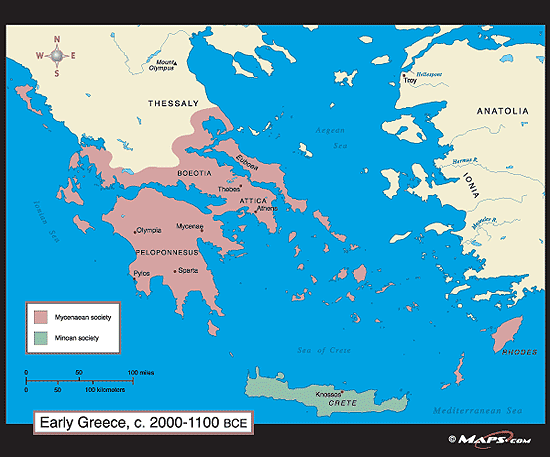Historical and Cultural Background
Introduction
Early Greece
Evidence for the Neolithic period (ca. 6000-3000 B.C.) has revealed settled agricultural communities (i.e., outlines of houses, pottery, tools, and graves).
It is conjectured that the Neolithic inhabitants came from the east and the north.
Evidence of religion seems apparent; particularly significant are little female idols, their sexuality exaggerated by the depiction of swollen belly, buttocks, and full breasts. Male figures also are found (some ithyphallic), although in far fewer numbers.
Was a fertility mother-goddess worshiped in this early period, and perhaps already associated with a m ale consort?
Classical Mythology, by Mark P. O. Morford, Robert J. Lenardon, p. 16
Early Greece map

NEOLITHIC PERIOD (6000 - 2900 BC)
The main characteristics of this era are the climate stabilization and the settlements of people. The Neolithic Revolution arrives with these people who traveled from Anatolia, Turkey. The economy of the region became steady with organized and methodical farming, stock rearing and, bartering and sculptures like pottery.
People stopped traveling from region to region and permanent settlements in Greece. They domesticated animals like sheep and goats and grew plants and crops. They made their bases around sites where there was ample water supply and in open landscapes.
The Neolithic Greece people can be said as the first 'farmers' and their lives were less complex and simple. Archeological findings show more settlements in Northern Greece, like Thessaly and Sesklo. Villages were found in Thessaly around 6500 BC while settlements in Sesklo started in 5500 BC. The inhabitants of these areas couldn't have been more than a hundred people. The houses were made of stone foundations with a roof made of a thick layer of clay and timber. Some were made of sticks and mud surrounded by fences.
The villagers made different types of attractive pottery like cups and dishes. Most of them were designed in a red and white pattern. The figurines that were created in the Neolithic Era were carved to suggest a female goddess. Offerings in the form of clay animals and birds to the goddess have been found in the caves. Till now, the oldest artifacts of Neolithic Era have been found in the Knossos region dating back to 3500 BC.
http://www.ancientgreece.com/s/History/#neolithic
Neolithic Religion
The religions of the Neolithic peoples provide evidence of some of the earliest known forms of organized religions. The Neolithic settlement of Çatalhöyük, in Asia Minor, was home to about 8,000 people and remains the largest known settlement from the Neolithic period. A striking feature of settlement are its female figurines. The original excavator argued that these well-formed, carefully made figurines, carved and molded from marble, blue and brown limestone, schist, calcite, basalt, alabaster, and clay, represented a female deity of the Great Goddess type. Although a male deity existed as well, “…statues of a female deity far outnumber those of the male deity.
http://atlantisonline.smfforfree2.com/index.php?action=printpage;topic=2907.0
The Bronze Age
The Bronze Age is divided into three major periods: Early, Middle, and Late. These periods are also labeled according to the geographic areas.
In Crete, the Bronze Age is Minoan (from the tradition of King Minos).
For the neighboring islands, the term is Cycladic (the islands that encircle Delos).
In Greece, it is called Helladic (Hellas is the Greek name for the country).
The Late Bronze Age on the mainland is also known as the Mycenaean Age, from the citadel of power (Mycenae) dominant in Greece during this period.
http://en.wikipedia.org/wiki/Mycenaean_Greece
A WORKABLE THUMBNAIL CHRONOLOGY
- Stone Age
Paleolithic (Old Stone Age) before 70,000 B. C.
Neolithic (New Stone Age) ca. 6,000–3,000 B. C.
The Bronze Age (named Minoan for Crete, Cycladic for the Cyclades, the islands of the Aegean, and Helladic for mainland Greece, Hellas).
- Early Bronze Age (3000–2000 B. C.)
| Early Minoan | Early Cycladic | Early Helladic |
- Middle Bronze Age (2000–1600 B. C.)
| Middle Minoan | Middle Cycladic | Middle Helladic |
- Late Bronze Age (1600–1100 B. C.)
| Late Minoan | Late Cycladic | Late Helladic (also called Mycenaean because of the powerful city of Mycenae) |
Paleolithic Age. Greece was inhabited at this time, but our knowledge remains scanty.
Neolithic Age. A migration of people from east and north of Greece settled into agricultural communities to judge from the archaeological remains: the foundations of dwellings, pottery, tools, and graves. The presence of small female “fetishes” or icons with exaggerated feminine characteristics have fostered the notion that this civilization worshiped a mother goddess. Smaller numbers of male statuettes have been interpreted by some as her lesser male consort.
Bronze Age. The Bronze Age followed the Neolithic period with inhabitants moving into Greece, Crete and Cyclades from the east. To these peoples are attributed the construction of Minoan civilization on Crete.
http://www.oup.com/us/companion.websites/9780195397703/student/materials/chapter2/?view=usa